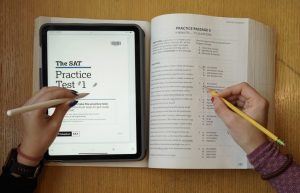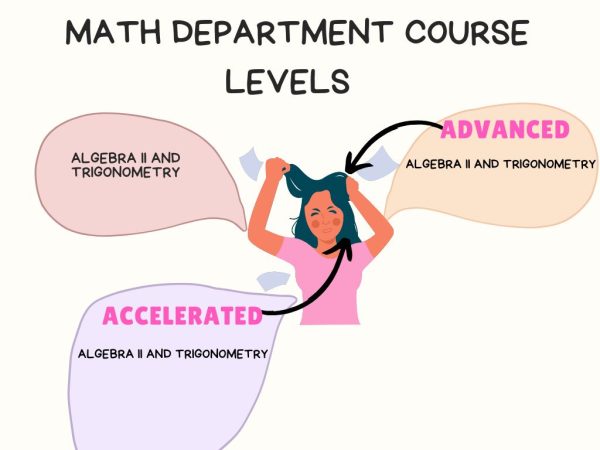Digital Changes to the SAT
 The SAT has long held a place of pride as the crucible of standardized testing. But does “standardized” necessarily mean “stagnant”? To meet this digital age, the College Board is set to digitize the SAT; with this new medium for the age-old scholastic standard, what can we expect to be changed? Are there any prospective benefits — and, if so, for whom?
The SAT has long held a place of pride as the crucible of standardized testing. But does “standardized” necessarily mean “stagnant”? To meet this digital age, the College Board is set to digitize the SAT; with this new medium for the age-old scholastic standard, what can we expect to be changed? Are there any prospective benefits — and, if so, for whom?
The current SAT reading section has 350–750 words per passage. The length of these passages results in many context-based questions, necessitating one’s full understanding of context and implicit meaning. This section tests the stamina of a student’s focus, constantly requiring one’s reading comprehension skills to be sharp under pressure.
However, the College Board has announced that the Reading Section will now consist of shorter passages, a word count of 25-125 words, with fewer questions assigned to them. The drastic decrease in context would reduce the amount of context-based questions, resulting in the creation of more direct questions. A shorter attention span would be required from the students, easing the fatigue a student may face from taking the test.
It is not just the Reading Section that is being shortened; the new digital SAT will be shortened as a whole. Originally three hours in length, “The SAT test will last approximately two hours, which reduces overall testing time by about an hour,” said Digital Marketing Director at KD College Prep, Emily Brehe-Gunter.
As a result, concern has been raised among some students: just how much of the SAT was taken out to reduce 33 percent of the entire test? With even more changes on their way, will students be able to handle these modifications?
During the two-year pandemic caused by the coronavirus, many students expressed concerns about learning from digital screens. These concerns have become linked to the SAT’s most notable change: its conversion from paper to digital. The College Board announced that instead of writing answers on a piece of paper, students will be required to type and submit answers on a personal device with a pre-downloaded exam applicationThe Harvard Business Review explains, “When you view something up close, a muscle inside your eye — known as the ciliary muscle — contracts and changes the shape of your lens to help you focus and see clearly… When you concentrate too hard on something, you blink less and that dries out your eyes and makes them more susceptible to eye fatigue.” Of course, the printed SAT, a multiple-hour-long test, would require focus, resulting in less blinking and therefore eye fatigue. However, the Harvard Business Review also proved that, “On average, people blink 15 to 20 times per minute, but when we stare at our computers, we end up blinking 66% less.”
Another concern lies in one of the most useful studies for the SAT: its vast amount of previous practice tests which students could access. The ability to see the SAT’s identical format grants the student a sense of familiarity when taking the test, as well as an idea of its difficulty. However, the College Board has now announced that the SAT sections, along with its respective directions and formats, will be modified. This depreciates the value of past practice tests, as their format and difficulty are no longer identical, which presents the student with an obstacle in no longer having a familiar guide through the SAT. In response, the College Board has assured families that the organization would “continue to release detailed preparation information for students, and all practice resources will be available digitally on our digital testing app and through Official SAT Practice on Khan Academy.”
The College Board has announced other changes as well; first and foremost, the SAT’s new adaptability. Each section will be split into two modules. In the first module, based on his or her performance, the test will choose a path containing easier or harder questions. Many may find this unfair: for example, a student who got nine questions right in the first module would be directed towards an easier set of questions, while a second student who got 10 questions right in the first module would be directed towards a harder set of questions.
Why should the difference of one question predetermine the difficulty of the SAT sections? Wouldn’t this be harmful to students? Co-Founder & Principal of the Compass Education Group, Adam Ingersoll, responds to these misunderstandings.
“No matter which second module they get, they likely arrive at the same score… The test is smart, and the test pegs them accordingly,” Ingersoll said. Furthermore, it is “highly unlikely that testers with top quartile potential would be routed to the easier second module.”
The clever adaptability of the digital SAT is explained by Mr. Ingersoll, revealing how unfairness is not only absent within the new test format, but that accommodations are being made to counter any possible issues students may have. Furthermore, it is a fact that these changes create a shorter test that will help students to avoid fatigue.“The SAT isn’t something that students should be worried about,” says College Counselor Rebecca Hall, since in all circumstances, “the students’ health always comes first”.










